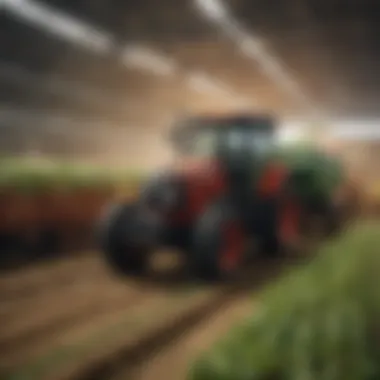Understanding Payment Processing in Agriculture


Intro
Understanding the mechanisms of payment processing in agriculture is crucial for all parties involved in the sector. Payment processing affects farmers, suppliers, and consumers alike. Efficient payment systems can lead to smoother transactions, reduced errors, and timely payments. With rapid technological advancements, the landscape of payment processing is changing. This is leading to new methods and techniques that can streamline operations in agriculture.
Stakeholders in agriculture face unique challenges because of the complex nature of the industry. This article explores these challenges in depth, while also emphasizing solutions that can improve the economic efficiency for everyone involved in agricultural transactions. By examining various payment methods and the implications they carry, this piece will offer insights into how the agricultural sector can adapt to modern financial practices.
Research and Data Analysis
Latest Trends in Agriculture and Horticulture
Several trends are influencing the agricultural landscape when it comes to payment processing. The rise of e-commerce platforms has changed the way farmers sell their products. Ideal for smaller farms, these platforms can facilitate quicker transactions. Additionally, interest in direct-to-consumer sales has surged, allowing farmers to engage more closely with their clients.
Farmers are also increasingly adopting mobile payment solutions. This provides them with flexibility, enabling transactions while out in the field. Such options reduce reliance on cash and check systems, aligning with consumer preferences for digital payments.
Statistical Insights into Crop Yields
Statistical data showcases the relationship between payment processing and crop yields. Research indicates that timely payments for supplies and labor can lead to better crop management. When farmers receive payments on time, they can invest in quality seeds and technology, ultimately improving yields.
"Timely financial transactions are a cornerstone of effective crop management."
Best Practices and Techniques
Efficient Crop Management Strategies
Farmers who leverage technology in their payment processing often find themselves at an advantage. Using software tools for invoicing, tracking expenses, and managing payments can enhance cash flow. This is particularly important during peak seasons when cash flow may be affected.
In addition, forming partnerships with financial institutions can help farmers secure better deals in payment terms. This means less pressure during harvesting periods when large outflows of cash are common.
Sustainable Horticultural Techniques
For suppliers, understanding payment methods that are sustainable is essential. Utilizing sustainable practices not only benefits the environment but can also attract consumers. The commitment to sustainability can lead to increased brand loyalty, ultimately improving financial transactions.
Effective payment processing can be part of a larger sustainability strategy, allowing hubs for direct transactions between consumers and producers.
Pest and Disease Management
Common Pests and Diseases in Crops
Understanding payment processing also includes the financial implications of pest and disease management within farms. Pests and diseases lead to significant losses if not managed properly. Emergency funds and insurance relied upon through effective payment processing can aid in recovery.
Integrated Pest Management Strategies
Utilizing an integrated pest management approach involves several financial considerations. Farmers must allocate resources properly. Payment systems that can track these expenditures enable more informed decisions about pest control measures and budgeting.
In closing, grasping the complexities of payment processing in agriculture provides numerous benefits for farmers and stakeholders. Technological advancements combined with a clear understanding of financial practices create a solid foundation for effective agricultural operations.
The Role of Payment Processing in Agriculture
Payment processing serves as the backbone of financial transactions within the agricultural sector. The efficient handling of payments can influence the profitability and sustainability of farming operations. When stakeholders from farmers to consumers engage in transactions, the method of payment and its processing can significantly affect both cash flow and relationships.
Definition of Payment Processing
Payment processing in agriculture encompasses the procedure through which financial transactions are completed. This process includes the acceptance, authorization, and settlement of payments between various parties involved. It can involve both physical methods, such as cash, and digital systems, like credit or mobile payments.


Understanding this process is essential for agricultural stakeholders. Farmers need to know how transactions work to manage their finances better. Payment processing ensures that funds are transferred reliably, which is crucial for operational continuity. Given that agriculture often involves large sums and numerous transactions, a clear grasp of payment processing is vital.
Importance of Payment Processing
The importance of effective payment processing in agriculture cannot be overstated. Here are several key reasons why it matters:
- Efficiency: Streamlined payment processes can significantly reduce transaction times. This efficiency helps in ensuring that farmers receive payments sooner, leading to improved cash flow.
- Security: Modern payment systems come with advanced security measures. Protecting sensitive financial information is crucial, especially in an industry where data breaches can be detrimental.
- Flexibility: Various payment options give farmers the ability to choose according to their clients' preferences. This capability can enhance customer relationships and widen market reach.
- Financial Management: Understanding payment systems aids farmers in tracking income and expenses. Proper records help in financial planning and forecasting.
- Technological Advancement: As payment technologies evolve, farmers who understand these changes can leverage them for competitive advantage. Staying updated with payment trends can lead to greater efficiency and reduced costs.
In summary, payment processing is not just a transactional tool; it’s a strategic component in agricultural economics. Stakeholders must continuously adapt to its evolving landscape to maximize their operational success.
Types of Payment Methods in Agriculture
Understanding the types of payment methods available in agriculture is crucial for optimizing financial transactions within the sector. Each method carries its unique advantages, limitations, and implications. Farmers, suppliers, and consumers should evaluate these modalities to select what aligns with their business needs. Understanding these payment mechanisms can also lead to more efficient and profitable operations.
Cash Payments
Cash payments remain one of the most traditional and straightforward methods in agricultural transactions. They typically do not incur transaction fees and allow for immediate exchange of goods and services. Farmers often prefer cash for its simplicity, as it does not require technological infrastructure or bank accounts. However, there are downsides. Handling large amounts of cash poses security risks, and it can be challenging to maintain accurate records, leading to potential financial discrepancies. Additionally, cash payments may not be viable for larger transactions, particularly for wholesalers or exporters who operate on a larger scale.
Digital Transactions
Digital transactions are reshaping the payment landscape in agriculture. This payment method includes online banking, e-wallets, and platforms like PayPal or Venmo. It offers enhanced convenience, allowing farmers and suppliers to transact beyond geographical limitations. Digital transactions save time and streamline the payment process, which can enhance customer satisfaction. A key consideration, however, is the reliance on internet access, which may be an issue in rural areas. Furthermore, users must be aware of potential cybersecurity threats associated with online payments.
Credit and Debit Systems
Credit and debit systems provide an additional layer of flexibility. Farmers can make purchases even when cash flow may not be optimal. Credit cards allow for deferred payments, which can assist in managing seasonal fluctuations in income. On the other hand, debit cards draw directly from a bank account, helping users avoid debt accumulation. Transaction fees are often a drawback, particularly high for smaller purchases. This may deter some farmers from using this method frequently. It's important to also consider the requirements for maintaining a merchant account to accept these types of payments, which may be complex for some.
Mobile Payment Solutions
Mobile payment solutions are rapidly gaining traction in agriculture. Applications like Apple Pay or Google Pay make transactions easy to conduct via smartphones. This method enhances immediacy and ease of use, especially in markets where speed is of the essence. Farmers can handle transactions at a moment's notice without needing bulky equipment. Yet, mobile solutions can require reliable internet access or data plans, often not available in rural settings. Additionally, there can be a learning curve for older farmers not as familiar with technology.
Payment Processing Technologies
Payment processing technologies play a crucial role in the agricultural sector. They enable timely transactions, which are vital for productivity. Farmers and stakeholders rely on seamless payment methods to thrive in a competitive market. Effective technologies enhance transparency and trust among parties involved. Moreover, these advancements often lead to cost reductions in transaction processes. As the agricultural landscape evolves, understanding these technologies becomes even more important for all participants.
Point of Sale Systems
Point of Sale (POS) systems are fundamental for managing transactions in agriculture. These systems streamline the sales process, allowing farmers to accept various payment methods easily. They can include hardware, like tablets or cash registers, combined with software that tracks sales and inventory. The advantage is clear: farmers can quickly process payments, reducing the time spent on financial tasks.
Furthermore, modern POS systems often integrate with other software, offering features such as sales analytics, customer relationship management, and inventory control. They help farmers make informed decisions based on data-driven insights.
Effective POS systems allow for real-time tracking of sales, which can optimize inventory management.
Blockchain in Agriculture
Blockchain technology offers a decentralized and secure way to process payments. This technology records transactions on a public ledger, ensuring transparency. In agriculture, it can build trust and accountability between farmers and consumers. Each transaction is recorded in a way that prevents alterations, securing the data against fraud.
Additionally, blockchain can enhance traceability in the supply chain. Stakeholders can track the journey of agricultural products from farm to table, ensuring quality and authenticity. This level of detail can also benefit farmers by improving their negotiation power as they can demonstrate the value of their products through verified data.
Cloud-Based Payment Solutions
Cloud-based payment solutions offer flexibility and scalability for agricultural transactions. These systems allow users to access payment processing tools from anywhere, easing the burden on farmers who may not always work from a fixed location. These solutions often come with lower setup costs and can be easily updated to incorporate new features or compliance requirements.
Security is a significant benefit as well. Most reputable cloud payment providers invest heavily in security measures. This reduces concerns regarding data breaches and protects sensitive financial information. Farmers and stakeholders can thus focus on their core activities without worrying excessively about payment security issues.
Challenges in Agricultural Payment Processing
Understanding the challenges in agricultural payment processing is essential for improving the economic dynamics of this sector. Successful payment processing not only affects the profitability of individual farmers and suppliers but also the efficiency of the entire agricultural supply chain. Addressing these challenges can lead to smoother transactions, greater trust among stakeholders, and ultimately better outcomes for consumers. Here, we explore specific issues such as fraud prevention, transaction fees, and regulatory compliance.
Fraud Prevention
Fraud is a significant threat in agricultural payment processing, posing risks not just to individual transactions but also to the integrity of the entire system. Farmers and suppliers often deal with large sums of money and quick turnovers, making them prime targets for fraudulent activities.


Implementing robust fraud prevention measures is crucial. This can involve utilizing advanced technologies such as encryption and two-factor authentication. Training stakeholders on recognizing potential scams is also vital. It is essential to ensure that everyone involved in the transaction process understands the signs of fraud and knows the protocols to follow if they suspect an issue. The consequences of falling victim to fraud can be dire; it can lead to financial loss, loss of trust, and even legal ramifications. Thus, proactive measures must be in place.
Transaction Fees
Transaction fees present another significant challenge in agricultural payment processing. These fees can vary widely depending on the payment method used, the technology provider, and even the volume of transactions. For farmers, particularly small-scale operations, high fees can reduce profit margins. They must then decide whether to absorb these costs or pass them onto consumers, which can influence pricing strategies.
To mitigate the impact of transaction fees, it is advisable to evaluate different payment methods. For instance, some digital payments might offer lower fees compared to traditional banking methods. Additionally, aggregating transactions can help in negotiating better terms with payment processors. Understanding the fee structures associated with different systems is critical for farmers to make informed decisions.
Regulatory Compliance
Regulatory compliance is a crucial component of effective payment processing in agriculture. Various laws and regulations govern financial transactions, and compliance is essential to avoid penalties and maintain operational legitimacy. For instance, farmers must adhere to tax regulations, anti-money laundering laws, and consumer protection standards when processing payments.
Keeping up with changing regulations can be daunting. It is advisable for agricultural stakeholders to stay informed about the regulatory landscape. This might involve working with legal experts or joining industry associations that provide resources and updates on compliance. Failing to comply with these regulations can lead to hefty fines and damage a business' reputation.
Improving Payment Processes in Agriculture
Improving payment processes in agriculture is crucial for streamlining transactions, reducing costs, and enhancing overall efficiency in the agricultural sector. This aspect is not merely about implementing technology but involves a holistic understanding of the payment ecosystem. It includes various components, such as standardization of payment methods, stakeholder training, and data analytics. These elements play a significant role in ensuring that transactions are secure, efficient, and user-friendly for all parties involved.
Standardizing Payment Methods
Standardization ensures that all stakeholders—from farmers to suppliers—can use similar payment methods across transactions. This improves clarity and reduces confusion, as it creates a uniform framework for conducting financial exchanges. By agreeing on a common set of payment processes, agricultural partners can eliminate inconsistencies that often lead to transaction errors.
Standardizing payment methods offers several benefits:
- Efficiency: Reduces time spent understanding different payment systems.
- Accessibility: Increases options for farmers, especially those in rural areas who may have limited access to certain payment methods.
- Cost-effectiveness: Lowers transaction fees when a common system is used widely.
Training for Stakeholders
Training is vital to ensure all parties involved are familiar with payment systems. This includes farmers, suppliers, and even local banks. Many users may not be comfortable with technology or complex payment solutions. With proper training, stakeholders can learn how to navigate these systems effectively. Training can include:
- Workshops: Hands-on sessions that explain how to use digital payment methods.
- Online Courses: E-learning platforms that offer flexibility for users to learn at their pace.
- Support Networks: Establishing peer networks where stakeholders can discuss and share experiences.
When all parties are well-informed, it results in fewer mistakes and faster transaction times. This, in turn, can lead to a more robust agricultural market.
Utilizing Data Analytics
Data analytics is a powerful tool that can enhance payment processes significantly. By analyzing transaction data, stakeholders can gain insights into spending patterns, seasonal trends, and payment method preferences. This information is invaluable for making informed decisions about future transactions.
Using data analytics offers:
- Predictive Analysis: Helps forecast demand and adjust payment methods accordingly.
- Fraud Detection: Identifying unusual patterns can help in detecting fraudulent activities.
- Performance Metrics: Evaluating how effective different payment methods are can lead to better strategies and optimizations.
Incorporating data analytics into payment processes not only improves efficiency but also supports strategic planning for agricultural businesses.
"Efficiency in payment processing directly impacts the economic viability of agricultural transactions, ultimately affecting food supply chains and consumer prices."
The Future of Payment Solutions in Agriculture
The landscape of payment processing in agriculture is shifting rapidly, driven by technological advancements and evolving market dynamics. Understanding the future of payment solutions in agriculture is crucial for various stakeholders, including farmers, suppliers, and consumers. This section addresses how emerging technologies, artificial intelligence, and sustainability initiatives are likely to influence payment practices, ensuring efficiency and security in transactions.
Emerging Technologies
Emerging technologies play a significant role in the evolution of payment solutions in agriculture. Innovations such as mobile payment systems, digital currencies, and blockchain are reshaping how transactions occur. Mobile payment solutions, for instance, have become increasingly popular among farmers and consumers for their convenience and accessibility. These technologies streamline the payment experience, reducing the time and effort needed for transactions.


Furthermore, blockchain technology offers a transparent and secure framework for payments. It can help verify transactions without the need for intermediaries, thus potentially lowering costs. As more farmers adopt these technologies, it can lead to a more interconnected and efficient agricultural marketplace.
Impact of Artificial Intelligence
Artificial intelligence (AI) is set to further enhance payment processing in agriculture. By utilizing AI, payment systems can analyze vast amounts of data to predict trends and optimize transaction processes. AI-enabled systems can help in fraud detection, ensuring safe transactions. Such systems can learn from previous patterns and improve their algorithms over time.
Additionally, AI can assist in automating various aspects of payment processing. This reduces the manual workload on farmers and business owners, allowing them to focus on their core activities. As AI technologies evolve, their integration into agricultural payment systems will likely lead to more personalized experiences for users, enhancing satisfaction and trust.
Sustainability in Payment Practices
Sustainability is becoming an essential consideration in payment practices within agriculture. Payment solutions that prioritize environmentally-friendly methods can contribute positively to the industry. This includes initiatives that support local currencies or cooperative payment systems, which often strengthen community ties and boost local economies.
Adopting sustainable payment methods not only benefits the environment but also aligns with consumer demand for responsible practices. Many consumers today are willing to support businesses that prioritize sustainability. Thus, implementing greener payment solutions can enhance a brand's reputation and attract more customers.
"Embracing sustainability in payment practices helps ensure that agriculture evolves to meet future challenges while also catering to the conscious consumer's preferences."
Analyzing Case Studies in Payment Processing
Analyzing case studies in payment processing is crucial for gaining practical insights into how systems work in real agricultural contexts. These studies illuminate not only what has been effective but also highlight the pitfalls that others may face. They serve as a bridge between theory and practice, providing applicable lessons for farmers and agricultural stakeholders.
Importance of Case Studies
Case studies allow for an in-depth exploration of payment strategies that have been successfully implemented. They demonstrate tangible results, showcasing improvements in efficiency, profitability, or user satisfaction. Additionally, they highlight innovative uses of technology, giving others a framework to experiment with. Considerations about geographical and economic differences can also be drawn from these case studies, making them valuable for wider audiences.
Successful Implementations
Successful implementations of payment processing systems in agriculture often focus on specific case studies that reveal effective practices. For example, a farm in California adopted digital payment systems that integrated with their existing Point of Sale systems. This allowed immediate transactions, reducing delay and providing real-time reporting.
Key aspects to note in these success stories include:
- User Adoption: It is vital that stakeholders are comfortable with the new systems.
- Scalability: The implemented systems should adapt as the business grows.
- Cost Efficiency: Successful implementations often demonstrate reduced transaction fees, improving overall margins.
"The move to digital payment solutions has saved us time and reduced our overheads significantly."
This quote encapsulates the essence of why analyzing successful implementations can yield vital information for others in the field.
Cost-Benefit Analysis
Cost-benefit analysis serves as a tool to measure the financial implications of adopting new payment processing methods. By evaluating these costs against the benefits gained, agricultural business leaders can make informed decisions.
Factors to consider in this analysis include:
- Initial Investment: Upfront costs can be a barrier to many farmers.
- Operational Savings: How much time and money can be saved monthly?
- Market Competitiveness: Will adopting a new system allow for better pricing or improved market reach?
Each case study offers a different angle on these factors, allowing farmers to gauge potential returns on investment. Through careful examination of financial data in successful case studies, stakeholders can construct realistic assessments of their payment processing strategies.
The End: Optimizing Payment Processing
In the realm of agriculture, optimizing payment processing is essential. This ensures that all transactions are efficient, secure, and cost-effective. By refining these processes, participants in the agricultural sector can mitigate risks, reduce errors, and enhance overall satisfaction between parties.
Summary of Key Insights
Throughout this article, we have explored multiple facets of payment processing in agriculture. The primary insights include:
- Diverse Payment Methods: Various methods exist, including cash payments, digital transactions, and mobile solutions. Each offers distinct advantages and challenges that stakeholders must consider.
- Technological Impact: Advancements such as blockchain and cloud-based solutions have the potential to streamline financial transactions and enhance transparency.
- Challenges: Stakeholders face challenges including fraud prevention, transaction fees, and regulatory compliance. Addressing these is crucial for any payment processing system to function effectively.
- Future Directions: Emerging technologies and practices focusing on sustainability suggest shifting trends in payment processing, indicating a need for adaptability.
These insights highlight the complexity of payment processing in agriculture, making it clear that continuous improvement is necessary for success.
Final Thoughts on Agricultural Payments
The future of agricultural payments lies in the embrace of efficient systems and innovative solutions. As the industry evolves, stakeholders must prioritize optimizing payment processes to keep pace with technological advancements and changing customer expectations. Maintaining a flexible approach will allow farmers and suppliers to navigate challenges effectively, ensuring financial stability and growth.
Moreover, fostering collaboration among stakeholders—farmers, suppliers, and consumers—will result in enhanced understanding and improved payment systems. This collective effort can lead to more sustainable practices that benefit the agricultural landscape.
Ultimately, optimizing payment processing is not just about technology; it is about creating a robust environment that supports economic growth and resilience in agriculture.
"Efficient payment processing is the backbone of economic health in agriculture."













